Bruce Lee is a legend.
He revolutionized motion pictures and martial arts.
He additionally boasted unbelievable energy and all-around physicality.
Lee may place his fist one inch from the chest of a person twice his dimension and unleash a fast, cobra-like strike that’d ship his opponent flying.
Lee may carry out push-ups utilizing simply two fingers of 1 hand.
Lee wasn’t big, however his lean, chiseled, outlined physique was broadly admired, and bodybuilders like Arnold Schwarzenegger, Lou Ferrigno, Flex Wheeler, Shawn Ray, and Dorian Yates all acknowledged the impression it had on their careers.
Co-star and fellow martial artist Chuck Norris described Lee’s ripped physique as “muscle upon muscle.”
A girl who requested if she may contact Bruce Lee’s flexed bicep (a typical request he appreciated receiving) described it as “heat marble.”
How did Lee develop his energy and physique? Was he merely a genetic freak?
Nope. In case you have a look at early footage of the Little Dragon, he was a fairly scrawny man.
As an alternative of genetics, Lee systematically and relentlessly constructed his physique with bodily coaching.
Because of the meticulous analysis of martial artist and author John Little, we all know precisely what Lee did to attain his outcomes. Little shares the main points of Lee’s health coaching in his 1998 guide Bruce Lee: The Artwork of Expressing the Human Physique. The guide is an absolute gold mine of health historical past and data, and I extremely suggest selecting up a replica.
In as we speak’s article, we check out the ideas that knowledgeable Bruce Lee’s coaching and the parts of his routine that turned a person right into a legend.
The Second Bruce Lee Bought Critical About His Bodily Coaching

All through his childhood, Lee was extremely lively. He received in hassle in school, and his spiritedness drove him to mischief and avenue fights. If Lee had grown up within the twenty first century, he in all probability would have been recognized with ADHD. His hyperactivity impressed his household to name him “by no means sits nonetheless.”
To channel Lee’s vitality into much less harmful actions, his father signed him up for kung fu instruction underneath the tutelage of grasp Ip Man. Thus, at age 13, Bruce started the lifelong apply that might make him a worldwide legend.
By the point Lee was in his twenties, he had developed sufficient bodily conditioning to excel as a martial artist, however remained a thin man.
Then got here a second that might take his bodily coaching to the following degree.
Within the early Nineteen Sixties, Lee lived in Oakland, CA, and had begun instructing kung fu. Lee didn’t discriminate in who he took on as a pupil, and based on some accounts, some conventional Chinese language kung fu masters within the space weren’t proud of him instructing the martial artwork to non-Chinese language. So in 1964, they offered an ultimatum to Lee: participate in a kung fu battle towards their finest fighter; if Lee misplaced, he needed to shut down his kung fu class.
Whereas completely different variations of precisely how the struggle went down exist, based on Bruce, the struggle lasted three minutes and primarily concerned him chasing his opponent round a constructing till he pressured him to submit.
Regardless of successful, Lee was disillusioned with how he carried out. He was sad in regards to the form he was in and had begun to really feel that the parameters of conventional martial arts had been impractical for avenue fights. He concluded that to comprehend his full bodily potential and grow to be one of the best martial artist on the earth, he’d want to maneuver past kung fu and develop his repertoire of bodily modalities.
This second of discontent not solely impressed Bruce Lee to get critical about his bodily health, however birthed a martial artwork and general life philosophy he referred to as Jeet Kune Do or the Approach of the Intercepting Fist.
The Sources of Bruce Lee’s Bodily Coaching Philosophy
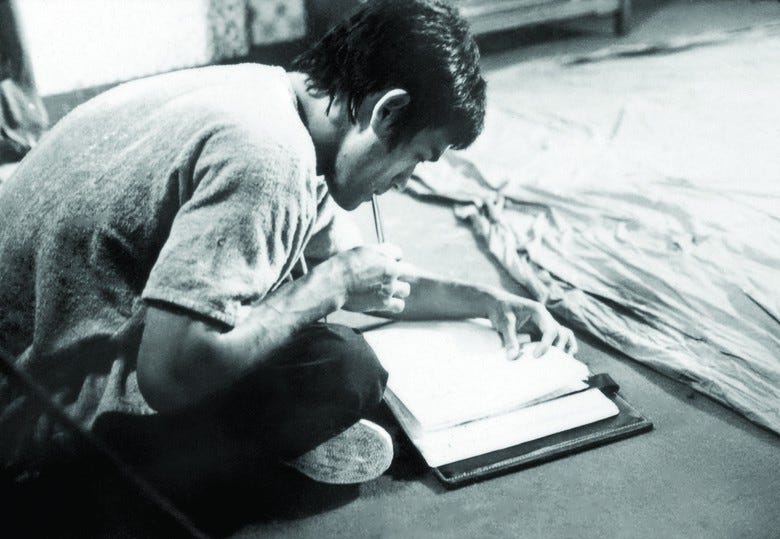
In shifting ahead from the struggle, Lee sought to develop a bodily coaching system that emphasised “practicality, flexibility, pace, and effectivity” and drew from a variety of coaching strategies.
Whereas Jeet Kune Do feels like a proper martial artwork fashion like Tae Kwon Do, Lee supposed it to be “the fashion of no fashion” — a martial artwork that transcended formal guidelines and integrated one of the best concepts from numerous disciplines.
To seek out these concepts, Lee turned a loyal pupil of the artwork and science of bodily coaching.
Despite the fact that Bruce had struggled at school, he had a powerful dedication to steady studying and was a voracious reader all through his maturity. Over his life, he amassed an enormous private library of over 2,500 titles.
He educated his thoughts by studying Jap and Western philosophy (Summa Theologica by St. Thomas Aquinas; The Guide of 5 Rings by Miyamoto Musashi), in addition to American self-help (As a Man Thinketh by James Allen; The way to Win Associates and Affect Folks by Dale Carnegie).
He additionally religiously studied every thing he may get his arms on about coaching the physique.
Lee thought there was one thing to be realized from all combatives and browse books about boxing by Jack Dempsey, Joe Louis, and Rocky Marciano, texts on karate and aikido, and over sixty volumes on fencing.
Within the Nineteen Sixties, bodybuilding magazines had been the first sources of data on energy coaching, and Bruce Lee subscribed to all of them. If he discovered an article that contained helpful data, he’d clip it and put it in his submitting system.
Lee additionally browsed used bookstores and acquired copies of well being and health books from the late nineteenth and early twentieth centuries, together with Power and The way to Get hold of It by bodybuilder and strongman Eugen Sandow and The Software of Measurement to Well being and Bodily Schooling written in 1945 by H. Harrison Clarke.
Lee continued so as to add health books to his intensive library all through his life and by no means let a set lens contort his studying decisions; if a guide or journal had some helpful data in it, he purchased it and browse it.
In addition to magazines and books, Lee would ask his mates and college students for coaching recommendation. Two males who had an enormous affect on Lee’s bodily schooling had been James Yimm Lee and Allen Joe. James Lee (no relation to Bruce Lee) was an Oakland-based martial artist and weightlifter, and Allen Joe was the primary Chinese language-American bodybuilding champion. Each males launched Lee to the way in which of the iron and helped develop his first weightlifting program.
For a fuller listing of the various books in Bruce Lee’s private library, take a look at this text.
The Parts of Bruce Lee’s Bodily Coaching
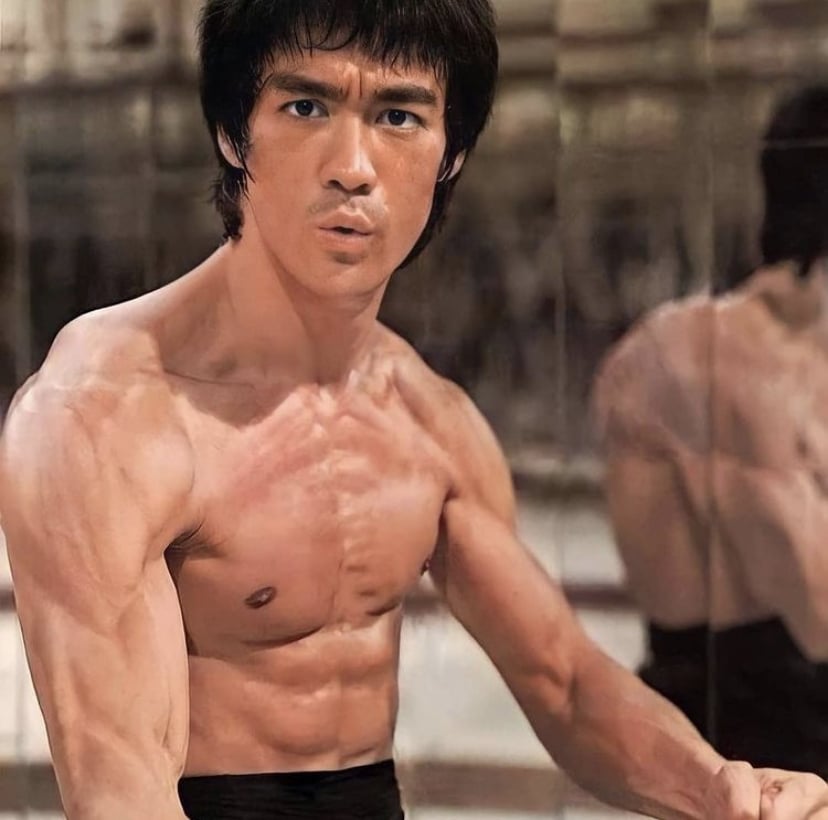
In case you’re speaking about fight — as it’s — nicely then, child, you’d higher practice EVERY a part of your physique.
— Bruce Lee
Lee’s research of all points of bodily coaching led him to experiment with completely different health modalities, together with barbell coaching, isometrics, plyometrics, circuit coaching, operating, and stretching.
His apply of those numerous modalities all had a single purpose: turning into a greater martial artist.
Whereas Lee solely selected workout routines that might assist him enhance as a fighter, as a result of martial arts require the total spectrum of bodily capabilities (energy, energy, pace, endurance, and suppleness), Lee systematically educated all these capabilities; he didn’t specialize.
Beneath, we’ll have a look at the primary parts of his bodily coaching:
Weightlifting
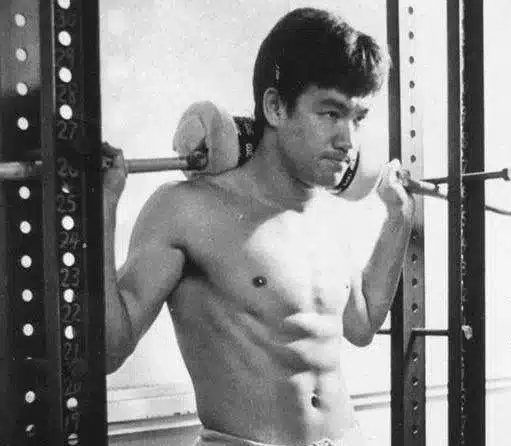
Because of his analysis and his personal expertise, Lee developed a deep appreciation for bodily energy and believed it was the muse of all different bodily capacities. In case you get stronger, you’ll be able to transfer quicker, with extra energy, for longer intervals of time.
And the simplest and environment friendly technique to get stronger is thru resistance coaching.
Within the early a part of his coaching profession, Lee used isometrics to construct energy. Then he found the effectiveness of barbell coaching and started to pump iron.
Whereas Lee’s weightlifting programming advanced all through his life, if you happen to have a look at his programming as an entire, 5 key parts emerge:
Compound Actions: One of many ideas of Jeet Kune Do was financial system of movement — utilizing the shortest and most direct path to attain the specified end result and minimizing wasted motion and vitality.
Thus when Lee selected an train for a exercise, he seemed for ones that would give him essentially the most bang for his buck, like compound lifts, which work a number of muscle teams concurrently, selling general energy and energy. Lee was a fan of squats, clear and presses, bench presses, and rows, feeling that these actions not solely had excessive ROI for constructing energy, but in addition achieved the concord between muscle teams that was important for optimum energy technology in martial arts.
Low Quantity: Whereas many sources declare that Lee used extraordinarily excessive repetitions, John Little’s intensive assessment of Lee’s exercise information confirmed that he sometimes employed a reasonable rep vary of 8-12 reps per set for many workout routines. The exception was leg coaching, the place he did favor increased repetitions and aimed for 12-20 reps per set.
Lee additionally stored the amount of his exercises low, doing solely 1-2 units per train. Lee was doing Mike Mentzer’s Heavy Obligation program earlier than Mike Mentzer.
Progressive Overload: Lee firmly believed within the overload precept and constantly strove to extend the calls for on his physique for steady enchancment. Relying on his health objectives on the time, he’d attempt to obtain progressive overload by including weight, rising repetitions, or decreasing his exercise time.
Give attention to Velocity: Lee prioritized pace and energy as a result of they typically distinguished an excellent fighter from a median one. He understood that energy is the power to specific energy shortly. To that finish, he typically integrated velocity work into his weight coaching. As an alternative of utilizing gradual, managed actions, Lee would make the concentric a part of the raise fast and explosive.
Minimalist Method: One other precept of Jeet Kune Do was simplicity, and this was mirrored in Lee’s continuous refinement of his weightlifting applications; he labored to eradicate pointless workout routines to optimize outcomes from minimal work. In case you have a look at the evolution of Lee’s weightlifting exercises, they received shorter and shorter; he went from doing hour-and-a-half lengthy exercises with a bunch of workout routines to a exercise with only a few actions that could possibly be achieved in lower than half-hour. By specializing in an efficient collection of compound lifts, achieved at low quantity, he received the outcomes he wished briefly, intense exercises.
Whereas Lee’s barbell-training exercises advanced over time, he ultimately settled on a program during which he did a 20-minute session 3X per week (Tuesdays, Thursdays, and Saturdays) that always seemed like this:
- Clear and press: 2 units of 8 reps
- Squat: 2 units of 12 reps
- Barbell pullover: 2 units of 8 reps
- Bench press: 2 units of 6 reps
- Good mornings: 2 units of 8 reps
- Barbell curl: 2 units of 8 reps
Along with normal weight coaching, one space of his physique that Bruce Lee took time to do particular workout routines for was his forearms; we’ll be dedicating an entire put up to his forearm-training routine down the highway.
Cardio
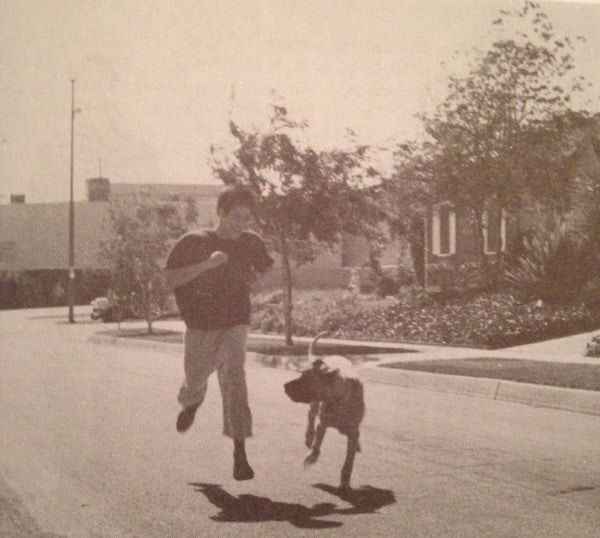
Lee caught the jogging bug within the Nineteen Seventies. He thought operating was an efficient and protected approach to enhance his stamina and endurance. He’d jog two to 6 miles on Mondays, Wednesdays, and Fridays and would all the time have a pair of sneakers with him so he may get a run in even when he was away from dwelling.
Lee integrated the progressive overload precept into his operating by rising his pace or distance. He was additionally an early practitioner of the “heavy arms” methodology of cardio exercise and would maintain mild dumbbells or put on ankle weights whereas operating.
Lee would typically complement the operating he did for cardiovascular well being by biking or leaping rope on Tuesdays, Thursdays, and Saturdays.
Stretching
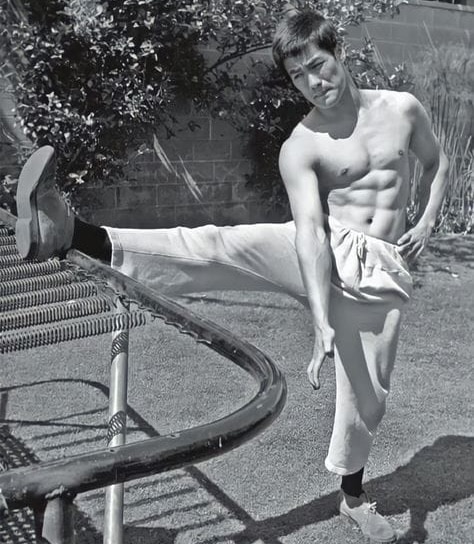
You’ve seemingly seen footage of Lee displaying his phenomenal flexibility with one among his excessive kicks. That flexibility got here from his dedication to each day stretching. Upon rising and earlier than he received off the bed, he would do his “Wake-Up Routine” — a set of six stretches and physique activation workout routines:
- Full-body stretch: 5 occasions, sustaining stretch 3 seconds, relaxation 2 seconds
- Arch again: 5 occasions
- Leg tensing: 12 occasions, 3 seconds tensing, 2 seconds relaxation
- Stomach tensing: 10 occasions, 3 seconds tensing, 2 seconds relaxation
- Sit-up, contact toes: 5 occasions
- Bent-leg raises: 5 occasions
Later within the morning, Lee would spend 15 to twenty minutes on a full stretching routine. He even created particular gear that might enable him to progressively overload his stretches.
Right here’s an instance of what one among his stretching periods would appear like:
- Seated straight leg stretch
- Facet stretch
- Hurdle stretch
- Seated groin stretch/butterfly stretch
- Thigh stretch/standing quad stretch
- Entrance pulley stretch. This stretch required a pulley and cord set-up. Whereas standing, Lee would place one foot in a strap related to a rope after which pull on the rope, which might increase the leg right into a stretched place.)
- Facet pulley stretch. Similar as entrance pulley stretch however the leg was positioned in a aspect kick place.)
In addition to his devoted stretching periods, Lee would stretch all through the day. Whereas he was studying, he typically propped his leg up on a desk or desk so he may get in some stretching whereas he developed his thoughts.
Core Work
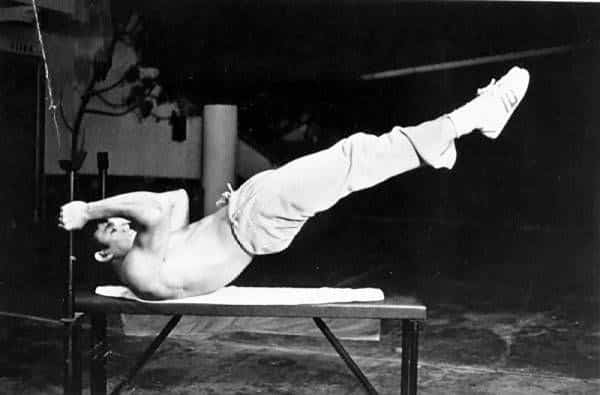
Lee believed that the stomach was the “middle or generator” of the physique as a result of it was the place within the physique that coordinates all its components and contributes to each punching and kicking energy. Consequently, Lee educated his abs every single day. The consequence was a robust core and a good, trim, 26-inch waist.
Along with the well-known dragon flag train, which Lee popularized, he did quite a few different workout routines for his abdomen and waist. Right here’s an instance of one of many each day ab routines Lee did:
- Sit-ups: 4 units of 20
- Facet bend: 4 units of 15 to twenty. Lee would maintain dumbbells in his arms to extend the depth of this motion.
- Leg raises: 4 units of 20
- Twists: 4 units of fifty. To carry out this motion, Lee would maintain a stick throughout his shoulders, bend ahead on the hips and twist proper, aiming the left stick finish towards his proper foot. After returning to the upright place, he would then twist left to deliver the appropriate stick finish towards his left foot.
- Frog kicks: 4 units of 20. Lee carried out this train by hanging from a pull-up bar and elevating his knees as much as contact his chest.
Punching and Kicking

In fact, martial arts coaching was a part of Lee’s bodily routine. He’d alternate days the place he’d work on combative leg strikes with days he’d give attention to arms and arms. He typically aimed to do 500 punches a day and threw a few of these punches whereas holding mild weights. He’d give attention to pace and endurance along with his kicking and punching periods, however would additionally practice energy by incorporating work with a heavy bag.
Beneath is a kicking and punching routine that Lee utilized in 1970:
Kicking
- Facet kick: left and proper
- Hook kick: left and proper
- Spin kick: left and proper
- Rear entrance thrust: left and proper
- Heel kick: left and proper
Punching
- Jab: pace bag, foam pad, prime and backside bag
- Cross: pace bag, foam pad, prime and backside bag
- Hook: pace bag, foam pad, prime and backside bag
- Overhand cross: pace bag, foam pad, heavy bag
- Combos: heavy bag, prime and backside pace bag
An Instance of Bruce Lee’s Coaching Routine
Lee educated all through the day, practically every single day. He did a number of hours of each day train, scheduled into morning, afternoon, and night periods that had been every centered on coaching a selected modality.
What he did throughout these periods advanced over time, based on what he had realized in his research, the actual film he was subsequent to star in, and his private objectives.
However to offer you an concept of how he introduced collectively the above parts and integrated them into his each day routine, right here is an instance of one among his coaching schedules from 1970:
Monday
- 7 AM to eight AM: Ab work and Flexibility
- 12 PM to 1 PM: Run
- 5:30 PM to six:30 PM: Punching
Tuesday
- 7 AM to eight AM: Ab work and Flexibility
- 12 PM to 1 PM: Resistance Coaching
- 5:30 PM to six:30 PM: Kicking
Wednesday
- 7 AM to eight AM: Ab work and Flexibility
- 12 PM to 1 PM: Run
- 5:30 PM to six:30 PM: Punching
Thursday
- 7 AM to eight AM: Ab work and Flexibility
- 12 PM to 1 PM: Resistance Coaching
- 5:30 PM to six:30 PM: Kicking
Friday
- 7 AM to eight AM: Ab work and Flexibility
- 12 PM to 1 PM: Run
- 5:30 PM to six:30 PM: Punching
Saturday
- 7 AM to eight AM: Ab work and Flexibility
- 12 PM to 1 PM: Resistance Coaching
- 5:30 PM to six:30 PM: Kicking
Sunday
The Overarching Secret of the Jeet Kune Do Solution to Bodily Health: Self-Expression

Take in what is beneficial; reject what’s ineffective, and add what’s particularly your individual.
—Bruce Lee
Maybe crucial part of Bruce Lee’s strategy to bodily coaching is that he made it uniquely his personal.
Every practitioner of Jeet Kune Do is inspired to develop his personal “private fashion” inside its framework. For Lee, each preventing particularly, and bodily coaching typically, was not some rote behavior you went by way of the motions with and rotely checked off your to-do listing every day. As an alternative, motion was one thing you set “emotional content material” and “passionate which means” into. For Lee, physicality was existential.
To achieve the heights of his potential, Lee created ever-changing coaching protocols that had been suited to him and his private objectives. He didn’t comply with cookie cutter applications. He didn’t comply with precisely what the consultants informed him he was alleged to do.
He experimented. He acted. He felt into his coaching till he had found his private coaching fashion — his technique to “absolutely specific the human physique.”
Supply:
Bruce Lee: The Artwork of Expressing the Human Physique by John Little

